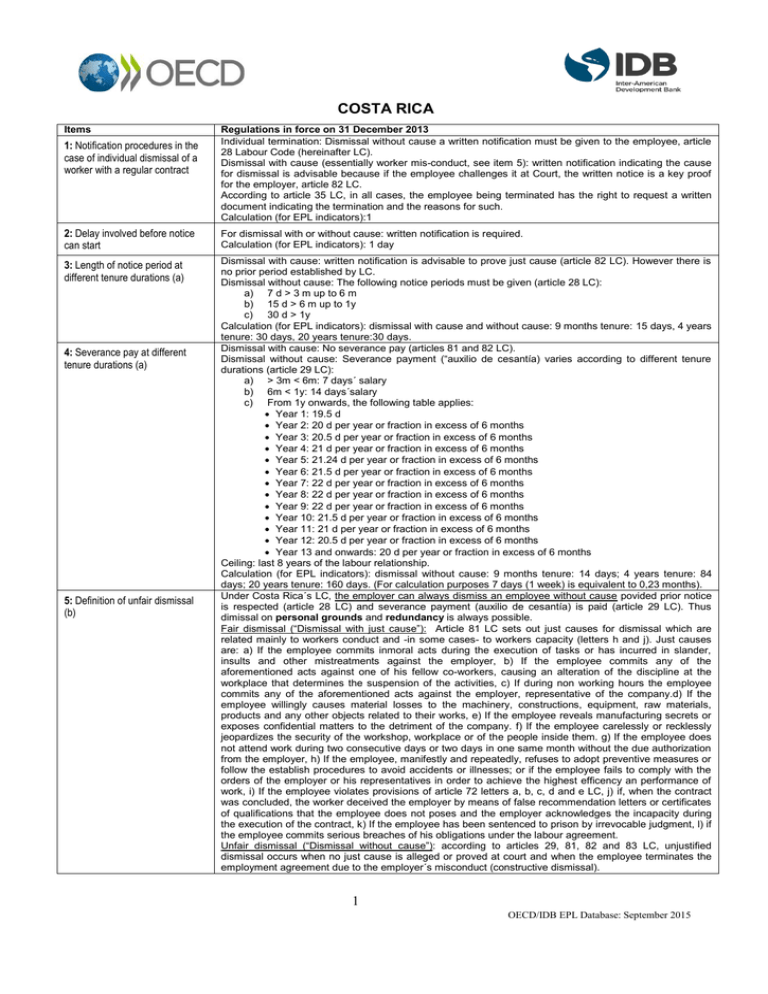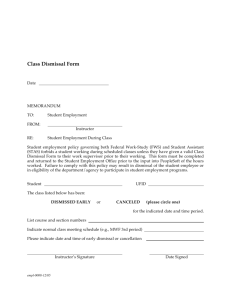costa rica
advertisement

COSTA RICA Items 1: Notification procedures in the case of individual dismissal of a worker with a regular contract Regulations in force on 31 December 2013 Individual termination: Dismissal without cause a written notification must be given to the employee, article 28 Labour Code (hereinafter LC). Dismissal with cause (essentially worker mis-conduct, see item 5): written notification indicating the cause for dismissal is advisable because if the employee challenges it at Court, the written notice is a key proof for the employer, article 82 LC. According to article 35 LC, in all cases, the employee being terminated has the right to request a written document indicating the termination and the reasons for such. Calculation (for EPL indicators):1 2: Delay involved before notice can start For dismissal with or without cause: written notification is required. Calculation (for EPL indicators): 1 day 3: Length of notice period at different tenure durations (a) Dismissal with cause: written notification is advisable to prove just cause (article 82 LC). However there is no prior period established by LC. Dismissal without cause: The following notice periods must be given (article 28 LC): a) 7 d > 3 m up to 6 m b) 15 d > 6 m up to 1y c) 30 d > 1y Calculation (for EPL indicators): dismissal with cause and without cause: 9 months tenure: 15 days, 4 years tenure: 30 days, 20 years tenure:30 days. Dismissal with cause: No severance pay (articles 81 and 82 LC). Dismissal without cause: Severance payment (“auxilio de cesantía) varies according to different tenure durations (article 29 LC): a) > 3m < 6m: 7 days´ salary b) 6m < 1y: 14 days´salary c) From 1y onwards, the following table applies: Year 1: 19.5 d Year 2: 20 d per year or fraction in excess of 6 months Year 3: 20.5 d per year or fraction in excess of 6 months Year 4: 21 d per year or fraction in excess of 6 months Year 5: 21.24 d per year or fraction in excess of 6 months Year 6: 21.5 d per year or fraction in excess of 6 months Year 7: 22 d per year or fraction in excess of 6 months Year 8: 22 d per year or fraction in excess of 6 months Year 9: 22 d per year or fraction in excess of 6 months Year 10: 21.5 d per year or fraction in excess of 6 months Year 11: 21 d per year or fraction in excess of 6 months Year 12: 20.5 d per year or fraction in excess of 6 months Year 13 and onwards: 20 d per year or fraction in excess of 6 months Ceiling: last 8 years of the labour relationship. Calculation (for EPL indicators): dismissal without cause: 9 months tenure: 14 days; 4 years tenure: 84 days; 20 years tenure: 160 days. (For calculation purposes 7 days (1 week) is equivalent to 0,23 months). Under Costa Rica´s LC, the employer can always dismiss an employee without cause povided prior notice is respected (article 28 LC) and severance payment (auxilio de cesantía) is paid (article 29 LC). Thus dimissal on personal grounds and redundancy is always possible. Fair dismissal (“Dismissal with just cause”): Article 81 LC sets out just causes for dismissal which are related mainly to workers conduct and -in some cases- to workers capacity (letters h and j). Just causes are: a) If the employee commits inmoral acts during the execution of tasks or has incurred in slander, insults and other mistreatments against the employer, b) If the employee commits any of the aforementioned acts against one of his fellow co-workers, causing an alteration of the discipline at the workplace that determines the suspension of the activities, c) If during non working hours the employee commits any of the aforementioned acts against the employer, representative of the company.d) If the employee willingly causes material losses to the machinery, constructions, equipment, raw materials, products and any other objects related to their works, e) If the employee reveals manufacturing secrets or exposes confidential matters to the detriment of the company. f) If the employee carelessly or recklessly jeopardizes the security of the workshop, workplace or of the people inside them. g) If the employee does not attend work during two consecutive days or two days in one same month without the due authorization from the employer, h) If the employee, manifestly and repeatedly, refuses to adopt preventive measures or follow the establish procedures to avoid accidents or illnesses; or if the employee fails to comply with the orders of the employer or his representatives in order to achieve the highest efficency an performance of work, i) If the employee violates provisions of article 72 letters a, b, c, d and e LC, j) if, when the contract was concluded, the worker deceived the employer by means of false recommendation letters or certificates of qualifications that the employee does not poses and the employer acknowledges the incapacity during the execution of the contract, k) If the employee has been sentenced to prison by irrevocable judgment, l) if the employee commits serious breaches of his obligations under the labour agreement. Unfair dismissal (“Dismissal without cause”): according to articles 29, 81, 82 and 83 LC, unjustified dismissal occurs when no just cause is alleged or proved at court and when the employee terminates the employment agreement due to the employer´s misconduct (constructive dismissal). 4: Severance pay at different tenure durations (a) 5: Definition of unfair dismissal (b) 1 OECD/IDB EPL Database: September 2015 6: Length of trial period (c ) 7: Compensation following unfair dismissal (d) 8: Reinstatement option for the employee following unfair dismissal (b) LC does not establish explicity a trial period, except for domestic workers. However, it should be noted that an employee has no right to prior notice (or payment in lieu of notice) or severance payment (auxilio de cesantía) unless he has been employed for a period of at least 3 months (articles 28, 80 and 102 LC). In case of unfair dismissal (article 29), the court will require the employer to pay the employee: 1) notice period, 2) severance payment (auxilio de cesantía), 3) back pay as from the date of the claim until court´s decision (article 82 LC), (if the employee challenges the just cause for dismissal at court). Calculation (for EPL indicators): 20 years’ tenure employee: back pay (6 months’ salary) plus pay in lieu of notice (30 days´ salary). No reinstatament option following unfair dismissal (for EPL purposes). Reinstatement is only allowed in case discrimination (race, sex, religion, age) article 624 LC and on pohibited grounds such as pregnant employees (articles 94 and 94 bis LC) or members of a trade union (articles 367 and 368). These situations are not considered for EPL purposes. 9: Maximum time period after dismissal up to which an unfair dismissal claim can be made (e) The maximum time period to claim for unfair dismissal if of 1 year (article 602 LC). 10: Valid cases for use of standard fixed term contracts FTC are permitted only to provide a service or perform a work which in its nature is of limited duration (articles 26 and 31LC). 11: Maximum number of successive standard FTCs (initial contract plus renewals and/or prolongations) General rule: The total duration of FTC cannot exceed 1 year. When the employee continues to render services, of the same nature, beyond the date of termination, the contract shall be considered of indefinite duration (article 27 LC). Special case: For services that require special technical preparation, the duration can be up to 5 years (article 27 LC). Article 27 LC states that FTC can be renewed. However the law does not specify the maximum number of renewals or prolongations. According to doctrine renewals are permitted only if the service is of limited duration. Renewals (as initial contract) are not permitted to perform services of a permanent nature. Thus FTCs are the exception. Calculation (for EPL indicators): Although LC allows renewals, as FTC are the exception, the assigned value is 2 (initial contract plus one renewal). 12: Maximum cumulated duration of successive standard FTCs 13: Types of work for which temporary work agency (TWA) employment is legal 14: Are there restrictions on the number of renewals and/or prolongations of TWA assignments? (f) 15: Maximum cumulated duration of TWA assignments (f) Although limit is regulated for initial contract (1 year/5 years), renewals follow the same limit. Calculation (for EPL indicators): average of general rule and special case: 72 months No statutory provisions in LC, except for definition of “Intermediario” as the person who engages the services of others to execute a work on behalf of an employer- beneficiary of the services. In such case both companies are jointly liable of labour and social security obligations (article 3 LC) . However Case Law (Sentencia Sala Segunda de la Corte N° 830. 1/10/2004/ Sentencia Sala Segunda de la Corte N° 863. 16/06/2010) defines TWA (citing doctrine) as the agencies which provide workers to satisfy temporary needs of the user firm (i.e meet short term requirements of the market, substitute a worker or cover a temporary vacancy during a selection process). No statutory regulation. FTC rules apply to FTCs between the agency and the worker. If assignments are of fixed-term, the duration of assignments and contracts typically coincide. No statutory regulation. FTC rules apply to FTCs between the agency and the worker. Applying this rule and considering that case law defines TWA as those agencies which provide workers for temporary services, the assumption of a time limit of 24 months/10years –for FTC- was considered. See Item 12 16: Does the set-up of a TWA require authorisation or reporting obligations? No special statutory regulation. 17: Do regulations ensure equal treatment of regular workers and agency workers at the user firm? No statutory regulation. 18: Definition of collective dismissal (b) No statutory definition of collective dismissal. However there are certain situations that determine the termination of all the employment agreements (article 85 LC): Fortuity or force majeure, insolvency, bankrupcy, liquidation procedures, death of the employer which determine the total closure of the business or final cease of the operations. 19: Additional notification requirements in cases of collective dismissal (g) Since collective dismissals are not regulated as such by the Costa Rican labour law, the termination of the employment agreements must be addressed individually and employers must give prior notice (or pay in lieu of notice) and pay severance indemnity. Thus there are no additional requirements on top on those requirements applying to individual dismissals. Calculation (for EPL indicators): 0 2 OECD/IDB EPL Database: September 2015 20: Additional delays involved in cases of collective dismissal (h) No additional delays involved. Calculation (for EPL indicators): 0 21: Other special costs to employers in case of collective dismissals (i) No special costs involved other than those required for individual termination (article 85 LC). Calculation (for EPL indicators): 0 Legend: d: days; w: weeks; m: months; y: years. For example “1m < 3y” means “1 month of notice (or severance) pay is required when length of service is below 3 years”. Notes: a) Three tenure durations (9 months, 4 years, 20 years). Case of a regular employee with tenure beyond any trial period, dismissed on personal grounds or economic redundancy, but without fault (where relevant, calculations of scores to compute OECD EPL indicators assume that the worker was 35 years old at the start of employment). Averages are taken where different situations apply – e.g. blue collar and white collar; dismissals for personal reasons and for redundancy. b) Based also on case law, if court practice tends to be more (or less) restrictive than what specified in legislation. c) Initial period within which regular contracts are not fully covered by employment protection provisions and unfair dismissal claims cannot usually be made. d) Typical compensation at 20 years of tenure, including back pay and other compensation (e.g. for future lost earnings in lieu of reinstatement or psychological injury), but excluding ordinary severance pay and pay in lieu of notice. Where relevant, calculations of scores to compute OECD EPL indicators assume that the worker was 35 years old at the start of employment and that a court case takes 6 months on average. Description based also on case law. e) Maximum time period after dismissal up to which an unfair dismissal claim can be made. f) Description based on both regulations on number and duration of the contract(s) between the temporary work agency and the employee and regulations on the number and duration of the assignment(s) with the same user firm. g) Notification requirements to works councils (or employee representatives), and to government authorities such as public employment offices. Only requirements on top of those requirements applying to individual redundancy dismissal count for the OECD EPL indicators (cf. Item 1). h) Additional delays and notice periods in the case of collective dismissal (only delays on top of those required for individual dismissals – as reported in Items 2 and 3 – count for the OECD EPL indicators). i) This refers to whether there are additional severance pay requirements and whether social compensation plans (detailing measures of reemployment, retraining, outplacement, etc.) are obligatory or common practice. 3 OECD/IDB EPL Database: September 2015


